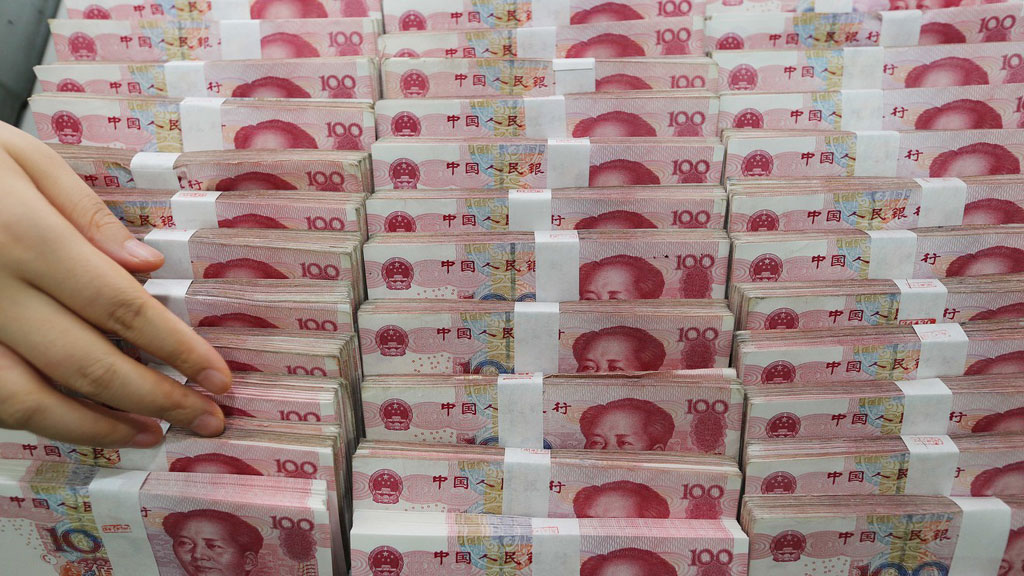 SHANGHAI/SINGAPORE: China's major state-owned banks have been active in the yuan forwards markets this week, sources said, using swaps to curb greenback supply as authorities sought to slow the currency's decline after its break past the key 7 to the dollar threshold.
SHANGHAI/SINGAPORE: China's major state-owned banks have been active in the yuan forwards markets this week, sources said, using swaps to curb greenback supply as authorities sought to slow the currency's decline after its break past the key 7 to the dollar threshold.
The move to contain the yuan's decline comes after the Sino-U.S. trade war broadened to include foreign exchange with Washington on Monday branding Beijing a currency manipulator for the first time since 1994.
That pushed the offshore yuan to a record low and the onshore currency past the psychologically important 7 to dollar mark for the first time in 11 years.
Four sources with knowledge of the matter told Reuters that state banks were seen swapping yuan for dollars in onshore forwards market to support the Chinese unit.
"Yesterday big banks were all selling one-year onshore forward swaps, then in the afternoon the spot dollar-yuan fell," said a trader at a foreign bank in Shanghai.
While China's central bank had allowed the yuan on Monday to break through key levels, authorities are keen to avoid a precipitous decline that could trigger capital outflows and destabilise wider financial markets.
The sources said banks had conducted significant amounts of buy-sell swaps in the onshore market on Tuesday. Buy-sell swaps help to reduce the supply of dollars that the market can access to short-sell the yuan.
Analysts and market participants say major state-run banks often act on behalf of the People's Bank of China (PBOC) in the country's foreign exchange market.
"The central bank is guiding the yuan to depreciate in an orderly manner, and therefore chances for a one-off sharp devaluation are low," said Ken Cheung, senior Asian FX strategist at Mizuho Bank.
He expects the PBOC will continue to use tools, including the daily midpoint fixing, to lead the yuan's movements in the near term.
One state bank also was seen active in offshore forward swaps, another two traders at foreign banks with knowledge of the matter said.
State banks have previously used such tactics to support the local currency. They were also seen selling forward dollars during the summer in 2018, pushing the one-year dollar/yuan swap points into negative territory, which implies an increase in the yuan's anticipated value against the dollar in a year's time.
One of the sources said while some of the recent swap transactions were believed to be rollovers of last year's purchases, other orders over the past two days were new.
In the past, the PBOC would only target yuan liquidity in the offshore market if it wanted temper the speed of currency moves. In late 2018, it sold yuan-denominated bills in Hong Kong to manage currency expectations.
"We believe China will manage the pace but not the direction of change for the renminbi," S&P Global Ratings said in a note. "More flexibility now should mean lower volatility in the future but some smoothing may be needed to anchor expectations and forestall large capital outflows."
On Wednesday, one-year onshore dollar/yuan forwards were at 175 points, down from 321 points on Monday, according to Refinitiv data. One-year offshore dollar/yuan forwards were at 459 points, down from 640 points on Monday.
Such state bank transactions in the forwards markets helped slow the decline in the spot yuan on Wednesday, although it was still weighed by an escalation in Sino-U.S. trade tensions and the central bank's move to set its official midpoint at an 11-year low.
The onshore spot yuan was trading at 7.0425 per dollar on Wednesday afternoon, down about 0.25% from Tuesday's late-session close.
The offshore yuan was trading at 7.0756 per dollar on Wednesday afternoon, down from the previous close of 7.0538.





















Comments
Comments are closed.